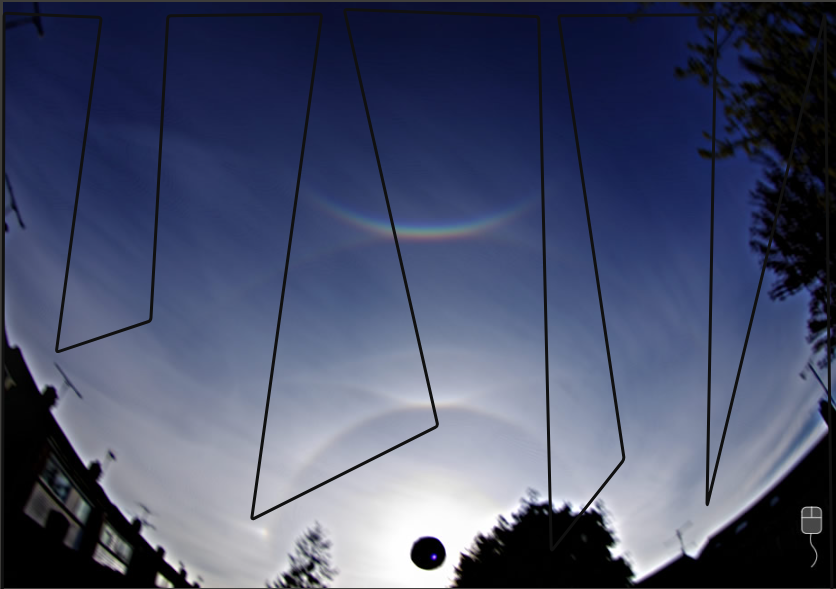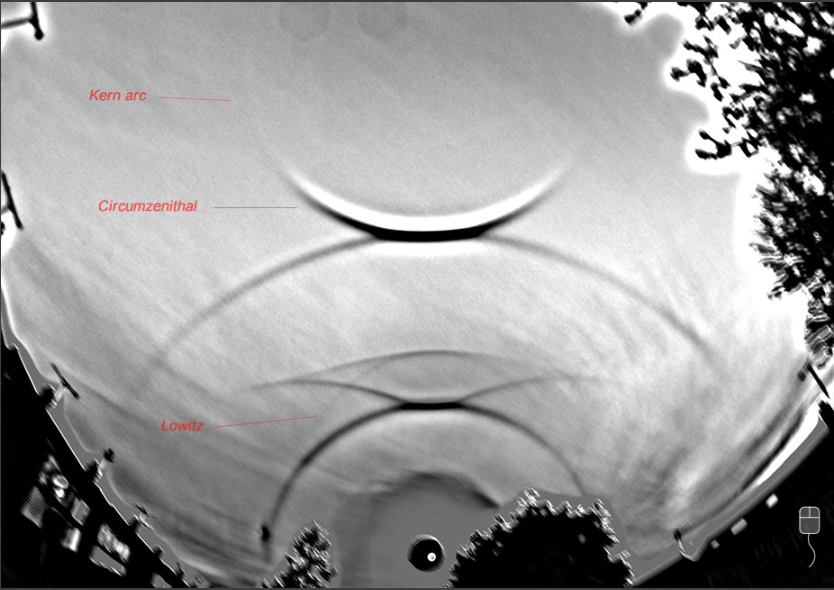Kern & Lowitz Arcs, England - OPOD
Kern & Lowitz Arcs: Rare Atmospheric Optics Phenomena in England
In the world of atmospheric optics, there are some truly rare and remarkable phenomena that can occur. One such example is the sighting of Kern and Lowitz arcs, which were captured in an exceptional display over Berkshire, Southern England on April 20, 2015. The photographer, Reima Eresmaa, initially noticed nothing out of the ordinary except for the intermittently visible upper suncave Parry arc. However, upon further inspection and through the application of heavy processing techniques, several rare halos became apparent.
The images captured by Reima Eresmaa demonstrate that even in seemingly mundane halo displays, the very rarest of gems can be hidden. The heavily processed grey-scale image reveals the true visual appearance of these arcs. The presence of these arcs highlights the beauty and complexity of atmospheric optics.
During the display captured by Eresmaa, a variety of rare arcs were observed. The upper Lowitz arc, which is strong in the images, is believed to have originated from Parry-Lowitz oriented crystals. Additionally, there were hints of rare Parry supralaterals (Tape) arcs, which are rarely seen in high cirrus clouds but more commonly occur from snow blower crystals above ski slopes.
One of the arcs observed in this display is known as the Kern Arc. It is a full circular continuation of the circumzenithal arc. The Kern Arc is much rarer than Lowitz arcs and has only been visually reported a few times. In 2007, it was finally captured on camera by Marko Mikkilä. The formation of the Kern Arc involves horizontal plate crystals with improbably thick or quasi-triangular aspect crystals where alternate side faces are long and short.
To better understand the rarity and intricacy of these arcs, HaloSim ray tracing was employed. This ray tracing technique revealed other rare arcs present in Reima Eresmaa's processed images. The projection of the ray tracing is an all-sky view centered on the zenith, providing a comprehensive visualization of these atmospheric phenomena.
The discovery of Kern and Lowitz arcs in the atmospheric optics field showcases the ongoing exploration and study of these fascinating natural occurrences. It reminds us that even in the seemingly ordinary, extraordinary beauty can be found. The rarity of these arcs highlights the importance of capturing and documenting such events to further our understanding of atmospheric optics.
In conclusion, the Kern and Lowitz arcs observed in England serve as a testament to the wonder and complexity of atmospheric optics. These rare phenomena, captured by dedicated photographers and studied through advanced techniques, offer valuable insights into the intricate workings of our atmosphere. As we continue to explore the world of atmospheric optics, it is discoveries like these that drive our curiosity and expand our knowledge of the natural world.


OpticsKern & Lowitz Arcs
An exceptionally rare sighting by Reima Eresmaa over Berkshire, Southern England late afternoon on April 20, ’15.
“At first glance there was nothing extraordinary about the display except the intermittently visible upper suncave Parry arc. However, by stacking sequences of images on top of each other and applying some quite heavy processing several rare halos became apparent.”
The grey-scale image is Reima’s heavily processed version. Mouse over it for a version closer to the visual appearance.
The pair nicely demonstrate that the very rarest of gems can hide in even mundane halo displays.
More of Reima's images here & ones enhanced by Nico Lefaudeux here.
Images ©Reima Eresmaa, shown with permission

This HaloSim ray tracing shows other rare arcs in Reima's processed images. The projection is an all-sky view centred on the zenith.
The upper Lowitz arc is strong in the images and likely originated from Parry-Lowitz oriented crystals.
Besides the bright upper suncave Parry arc, there were hints of rare Parry supralaterals (Tape) arcs. Whilst these occur relatively frequently from snow blower crystals above ski slopes they are hardly ever seen in high cirrus.
The Kern Arc is a full circular continuation of the circumzenithal arc.
The Kern is much rarer than Lowitz arcs. After one or two reports of visual sightings, notably one during the great Saskatoon display of 1970, it was finally captured on camera by Marko Mikkil� in 2007.
Like the circumzenithal arc, it is formed by horizontal plate crystals but the Kern ray path needs improbably thick crystals or � more physically likely � ones of quasi-triangular aspect where alternate side faces are long and short.
Kern arc rays enter a top hexagonal face, reflect internally from a side face and then exit through a second adjacent side face.
Note: this article has been automatically converted from the old site and may not appear as intended. You can find the original article here.
Reference Atmospheric Optics
If you use any of the definitions, information, or data presented on Atmospheric Optics, please copy the link or reference below to properly credit us as the reference source. Thank you!
-
<a href="https://atoptics.co.uk/blog/kern-lowitz-arcs-england-opod/">Kern & Lowitz Arcs, England - OPOD</a>
-
"Kern & Lowitz Arcs, England - OPOD". Atmospheric Optics. Accessed on April 18, 2024. https://atoptics.co.uk/blog/kern-lowitz-arcs-england-opod/.
-
"Kern & Lowitz Arcs, England - OPOD". Atmospheric Optics, https://atoptics.co.uk/blog/kern-lowitz-arcs-england-opod/. Accessed 18 April, 2024
-
Kern & Lowitz Arcs, England - OPOD. Atmospheric Optics. Retrieved from https://atoptics.co.uk/blog/kern-lowitz-arcs-england-opod/.